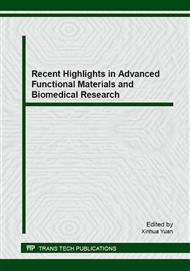[1]
H. Iwahara, Proton conducting ceramics and their applications, Solid State Ionics 86-88(1996) 9-15.
DOI: 10.1016/0167-2738(96)00087-2
Google Scholar
[2]
K.D. Kreuer, Proton-conducting oxides, Annu. Rev. Mater. Res. 33 (2003)333-359.
DOI: 10.1146/annurev.matsci.33.022802.091825
Google Scholar
[3]
G.Y. Meng, G.L. Ma, Q.L. Ma, R.R. Peng, X.Q. Liu, Ceramic membrane fuel cells based on solid proton electrolytes, Solid State Ionics 178(7-10) (2007)697-703.
DOI: 10.1016/j.ssi.2007.02.018
Google Scholar
[4]
A.K. Azad, J.T.S. Irvine, High density and low temperature sintered proton conductor BaCe0. 5Zr0. 35Sc0. 1Zn0. 05O3-δ Solid State Ionics 179(19-20) (2008)678 -682.
DOI: 10.1016/j.ssi.2008.04.036
Google Scholar
[5]
M. Amsif, D. Marrero-Lopez, J.C. Ruiz-Morales, S.N. Savvin, M. Gabás, P. Nunez, Influence of rare-earth doping on the microstructure and conductivity of BaCe0. 9Ln0. 1O3-δ proton conductors, J. Power. Sources 196 (2011)3461-3469.
DOI: 10.1016/j.jpowsour.2010.11.120
Google Scholar
[6]
T. Scherban, W. -K. Lee, A. S. Nowick, Bulk protonic conduction in Yb-doped SrCeO3 and BaCeO3, Solid State Ionics 28 -30, (1998) 585-588.
DOI: 10.1016/s0167-2738(88)80106-1
Google Scholar
[7]
N. Bonanos, B. Ellis, K.S. Knight, M.N. Mahmood, Ionic conductivity of gadolinium-doped barium cerate perovskites, Solid State Ionics 35(1-2), (1989)179-188.
DOI: 10.1016/0167-2738(89)90028-3
Google Scholar
[8]
Z.T. Tao, Zh.W. Zhu, H.Q. Wang, W. Liu, Astable BaCeO3-based proton conductor for intermediate-temperature solid oxide fuel cells, J. Power. Sources 195 (2010) 3481-3484.
DOI: 10.1016/j.jpowsour.2009.12.047
Google Scholar
[9]
L. Bi, Z. Tao, C. Liu, W. Sun, H. Wang, W. Liu, Fabricaiton and characterization of easily sintered and stable anode-supported proton-conducting membranes, J. Membr. Sci. 336(1-2) (2009) 1-6.
DOI: 10.1016/j.memsci.2009.03.042
Google Scholar
[10]
T. Esaka, Ionic conduction in substituted scheelite-type oxides, Solid State Ionics, 136-137(2000) 1-9.
DOI: 10.1016/s0167-2738(00)00377-5
Google Scholar
[11]
N. Nallamuthu, I. Prakash, N. Satyanarayana, M. Venkateswarlu, Preparation, characterization and electrical conductivity studies of nanocrystalline La doped BaMoO4, Mater. Res. Bull. 46(2011)32-41.
DOI: 10.1016/j.materresbull.2010.10.001
Google Scholar
[12]
Z.M. Zhong, Stability and conductivity study of the BaCe0. 9−xZrxY0. 1O2. 95 systems, Solid State Ionics, 178(3-4) (2007) 213-220.
DOI: 10.1016/j.ssi.2006.12.007
Google Scholar


